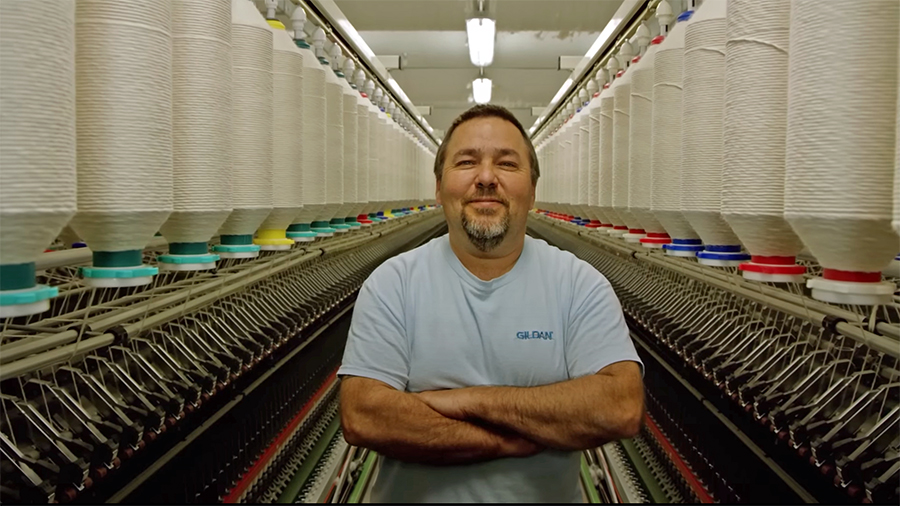Gildan Activewear, Inc. reported sales rose 3 percent in the second quarter as 6 percent growth in its activewear segment offset declines in hosiery and underwear from the phase-out of its sock license with Under Armour. Adjusted diluted EPS rose 17 percent year-over-year.
Improved gross margins due to lower raw material, manufacturing input and operating costs boosted earnings.
“I am proud of the Gildan team’s ongoing dedication, delivering a solid top-line performance in the second quarter with strong adjusted operating margin and double-digit adjusted diluted EPS growth. Further, I am excited to be back leading the company as we continue to focus on our Gildan Sustainable Growth Strategy (GSG) and celebrate a significant milestone with our company’s 40th anniversary this year. This is a period of significant opportunity in our industry, and we believe that Gildan’s competitive position has never been stronger,” said Glenn J. Chamandy, Gildan’s president and CEO.
Gildan’s chairman of the Board, Michael Kneeland, added “Gildan’s new directors bring a wealth of expertise and fresh perspectives, and the Board is excited about supporting the company in this next chapter, working closely with Glenn and the senior team and all stakeholders. Together, we look forward to achieving great success.”
Q2 2024 Operating Results
Net sales were $862 million, up 3 percent over the prior year, at the higher end of previously provided guidance of flat to low-single-digit growth.
Activewear sales of $737 million were up 6 percent, driven by increased shipments reflecting positive POS trends across all channels and geographies. A favorable mix was also driven by higher fleece replenishment by North American distributors ahead of the peak selling season.
Strong activewear sales in the quarter reflected continued market share gains in key growth categories, including fleece and ring-spun products. Gildan also said it benefited from a positive market response to its recently introduced products featuring key innovations, including soft cotton technology.
International sales increased by 7 percent as POS trends rebounded across all regions.
In the hosiery and underwear category, sales were down 16 percent versus the prior year, mainly due to the phase-out of the Under Armour business and, to a lesser extent, to an unfavorable mix and continued broader market weakness in innerwear. Excluding the Under Armour phase-out impact, hosiery and underwear sales would have been up mid-single-digits, year-over-year.
The company generated a gross profit of $262 million, or 30.4 percent of net sales, versus $217 million, or 25.8 percent of net sales, in the same period last year, representing a 460-basis-point improvement, primarily driven by lower raw material and manufacturing input costs.
SG&A expenses of $124 million included significant charges related to the proxy contest, leadership changes and related matters, totaling $57 million. Excluding these charges, adjusted SG&A expenses were down 15 percent to $66 million, or 7.7 percent of net sales, compared to SG&A expenses of $78 million, or 9.3 percent of net sales for the same period last year. The year-over-year reduction reflected the positive benefit of the jobs credit introduced by Barbados, retroactive to January 1, 2024, and totaled $17.2 million in the quarter.
The company generated an operating income of $141 million, or 16.4 percent of net sales, reflecting the negative impact of the expenses for the proxy contest, leadership changes and other related matters, compared to $183 million, or 21.7 percent of net sales last year which included a net insurance gain of $74 million and restructuring charges of $30 million.
Adjusted operating income was $196 million, or 22.7 percent of net sales, in line with the guidance provided and up $57 million, or 620 basis points, compared to the prior year.
Net financial expenses of $24 million were up $4 million over the prior year due to higher interest rates. The company’s income tax expense was significantly higher than the prior year, mainly reflecting the impact of the enactment of the Global Minimum Tax (GMT) in Canada and Barbados during the second quarter. This impact was retroactive to January 1, 2024, and the company’s adjusted effective income tax rate for the quarter was 27.2 percent versus 4.8 percent last year, bringing the year-to-date adjusted tax rate to approximately 18 percent, in line with company expectations.
Reflecting the positive benefit of a lower outstanding share base, GAAP diluted EPS was $0.35, down 60 percent versus the prior year, while adjusted diluted EPS was $0.74 compared to $0.63 last year, up 17 percent year-over-year.
Cash flows from operating activities totaled $140 million, compared to $182 million in the prior year, which included the net positive effect of the $74 million insurance gain. After accounting for capital expenditures totaling $36 million, the company generated approximately $104 million of free cash flow (FCF) compared to $126 million in the prior year, after absorbing a cash impact of $40 million in the quarter for the proxy contest, leadership changes and related matters.
The company resumed share repurchases in the final month of the quarter, repurchasing 3.1 million shares and, as such, returned a total of $182 million in capital to shareholders, including dividends during the second quarter.
With the current normal course issuer bid (NCIB) program approaching expiry this month, Gildan’s Board of Directors approved a new NCIB program to repurchase up to 10 percent of the company’s public float over the next twelve months. Gildan ended the second quarter with a net debt of $1,238 million and a leverage ratio of 1.6 times net debt to trailing twelve-month adjusted EBITDA.
Year-to-Date Operating Results
Net sales for the first half ended June 30, 2024, were $1,558 million, up 1 percent from the same period last year.
In Activewear, Gildan generated sales of $1,329 million, up $49 million or 4 percent, driven by higher shipments reflecting positive POS trends across North American and International markets. Activewear sales also benefited from a favorable product mix partly offset by lower net selling prices, primarily in the first quarter. POS trends for the Activewear category have continued to show progressive improvement over the past few quarters.
International sales of $123 million were up 4 percent versus the same period last year, reflecting demand stabilization and some recovery in POS trends.
Sales of hosiery and underwear were down 13 percent compared to the prior year, mainly reflecting the phase-out of the Under Armour business, a less favorable mix, and broader market weakness in the underwear category. Excluding the Under Armour phase-out impact, Hosiery and underwear sales would have been up low-single digits year over year.
The company generated a gross profit of $473 million, up $69 million versus the prior year, driven by the increase in sales and gross margin. Gross margin of 30.4 percent was up by 420 basis points year-over-year, mainly due to lower raw material and manufacturing input costs, partly offset by slightly lower net selling prices.
SG&A expenses were $229 million, $69 million above prior year levels. The increase is mainly attributable to expenses for the proxy contest, leadership changes and other related matters, totaling $76.8 million. Excluding these charges, adjusted SG&A expenses were $152 million, or 9.8 percent of net sales, compared to 10.4 percent of net sales last year, reflecting the benefits of the jobs credit introduced by Barbados retroactive to January 1, 2024.
The company generated an operating income of $246 million, or 15.8 percent of net sales, reflecting the negative impact of the expenses for the proxy contest, leadership changes, and other related matters. This compares to operating income of $311 million or 20.1 percent of net sales last year, which included the benefit of a $77 million net insurance gain and a $25 million gain from the sale and leaseback of one of its U.S. distribution facilities, partly offset by restructuring costs of $33 million. Excluding these items, as well as the expenses for the proxy contest, leadership changes, and other related matters, adjusted operating income was $321 million or 20.6 percent of net sales, up $80 million or 500 basis points compared to the prior year.
Net financial expenses of $47 million were up $9 million over the prior year due to higher interest rates. As detailed earlier, income tax expenses were significantly higher than the prior year due to the enactment of GMT in Canada and Barbados. Reflecting the benefit of a lower outstanding share base, GAAP diluted EPS and adjusted diluted EPS were $0.81 and $1.33, respectively, compared to GAAP diluted EPS and adjusted diluted EPS of $1.41 and $1.08, respectively, in the prior year.
2024 Outlook
Gildan said, “The company’s focus remains on executing the Gildan Sustainable Growth (GSG) strategy initiated in 2022. Substantial progress has been achieved on the three strategic pillars: capacity-driven growth, innovation and ESG. While we are encouraged by the positive demand trends for our products in all our channels in the first half of 2024, the macroeconomic backdrop remains mixed globally, which is driving a generally cautious consumer spending outlook. Nonetheless, we are reiterating our previously provided 2024 guidance, underscoring our confidence in our continued execution against our GSG strategy.”
Consequently, for 2024, Gildan continues to expect the following:
- Revenue growth for the full year to be flat to up low-single-digits;
- Adjusted operating margin slightly above the high end of its 18 percent to 20 percent target range for 2024;
- Capex to come in at approximately 5 percent of net sales;
- Adjusted diluted EPS in the range of $2.92 to $3.07, up between 13.5 percent and 18.5 percent year over year; and
- Free cash flow above 2023 levels, driven by increased profitability, lower working capital investments and lower capital expenditures than in 2023.
Image courtesy Gildan













